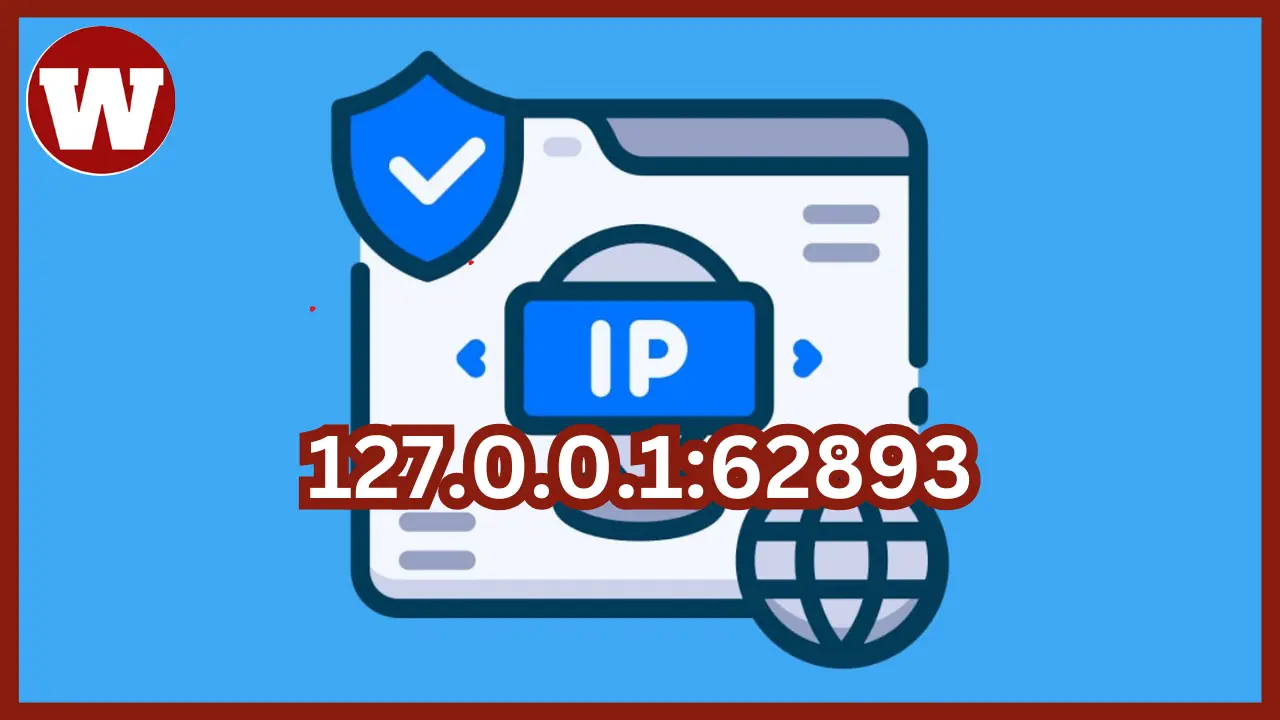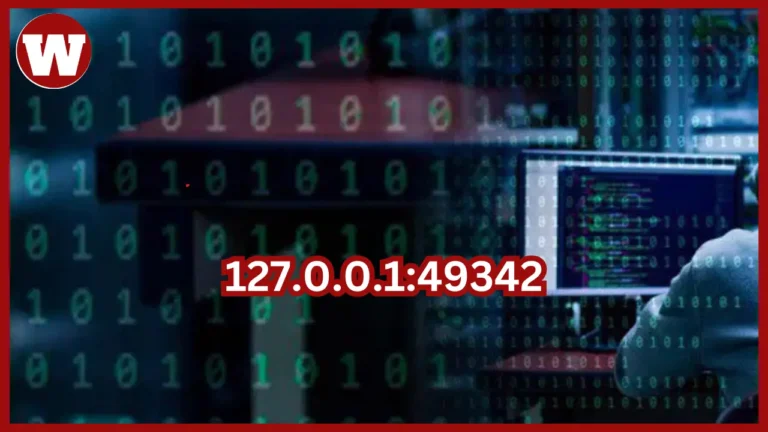When it comes to networking, the term 127.0.0.1:It might not be immediately obvious, but 62893 is important shorthand for a key concept used in local development and networking setups, and we can write cleverer software using it. The loopback address is commonly 127.0.0.1 and this is used by a computer to talk to itself so when testing out applications, external resources aren’t necessary. For example, 62893 is a port number, a gateway along which data flows so that services can be accessed from the local machine. Together, 127.0.0.1:It’s 62893, a combination of local resources needed for development, testing, and debugging work.
Understanding 127.0.0.1:62793, however, is also important for those who write the code, or developers, in addition to those who is troubleshooting, or IT professionals, still securing networks. This one plays a fundamental role in diagnosing system issues, identifying port conflicts, and making sure you run your applications clean. This article aims to delve deep into the significance of 127.0.0.1:Explore it, know its uses, its potential errors, how to troubleshoot it, and best practices for getting it to work.
In this comprehensive guide, we will explore everything you need to know about 127.0.0.1:From exploring the IP address and port number combination to figuring out the frequent issues and making the best of its use in secure and efficient development environments. Understanding 127.0.0.1 and Port 62893
What is 127.0.0.1?
127.0.0.1 is a reserved IP address, commonly referred to as the loopback address. This address is unique because it allows the host machine to send data to itself. Typically used for testing and network diagnostics, it doesn’t route packets through any physical network interfaces. Instead, it creates a virtual path for internal communication on the local machine. This address is part of the Class A IP range but is restricted for internal use, so it never leaves the local machine.
When developers work on software applications, 127.0.0.1 plays a significant role by enabling them to test their applications locally before deploying them to production environments. For instance, if you are developing a web application, using 127.0.0.1 allows you to view and test the site on your machine without making it available to external users. This capability is invaluable for testing application functionality, resolving bugs, and ensuring the software behaves as expected without exposing it to security risks posed by external traffic.
The significance of 127.0.0.1 goes beyond development; it’s also used by system administrators for tasks such as running network diagnostic tools, configuring servers, and even setting up firewalls. This loopback address forms the backbone of localized testing, making it indispensable for both developers and network professionals.
What is Port 62893?
A port, in networking terms, is a virtual gateway or endpoint used for specific types of data to be transferred between systems. Every IP address can have up to 65,535 ports available for various applications. Port 62893 is an arbitrary high-range port often utilized in development environments. When a service, such as a web server or database, is run locally, a specific port is used to handle incoming requests. Port 62893 is one of many that can be designated for this purpose.
The choice of 62893 for local development could be due to its availability. Developers often select high-numbered ports because they’re less likely to be in use by other system processes or services. 62893 can be bound to local applications or services for testing, making it a preferred choice when working in isolated environments where conflicts with other ports are minimized.
In local development setups, the use of 127.0.0.1:62893 allows developers to simulate real-world network conditions without depending on an external server. This combination ensures that applications can be thoroughly tested and debugged before being deployed to live environments. It’s a best practice to select a unique, unused port such as 62893 to avoid conflicts with other services.
Importance of Using 127.0.0.1:62893
Utilizing 127.0.0.1:62893 is essential for efficient development and testing. It allows a local machine to host services, interact with different components, and run tests in a controlled environment. Developers and network engineers rely on this setup to isolate issues, avoid conflicts with external networks, and ensure that services function properly before they are made available to users. Additionally, the loopback address ensures that data is securely confined to the local machine, providing a safe environment for testing sensitive applications.
In scenarios where multiple services are being developed, using a distinct port like 62893 for each service allows them to run simultaneously without interference. For example, a web server could run on 127.0.0.1:62893, while a database server runs on 127.0.0.1:5432. This segregation makes it easier to test interactions between various components of an application.
Common Errors Associated with 127.0.0.1:62893

1. “Disconnected from the Target VM” Error
One of the most common issues developers encounter when working with 127.0.0.1:62893 is the “Disconnected from the target VM” error. This error typically occurs when there’s a disruption in the communication between the local machine and the virtual machine (VM) that the developer is using. The issue can be caused by several factors, such as improper configuration of the VM, network instability, or miscommunication between the host system and the VM.
To resolve this error, start by verifying the settings of your VM. Ensure that it is properly configured to communicate through 127.0.0.1 and the port in question, 62893. Restarting the VM often resolves temporary glitches, but persistent issues may require checking the network configuration of both the VM and the host system. Additionally, make sure that the VM’s firewall isn’t blocking local traffic to 127.0.0.1:62893, as security settings may sometimes interfere with this communication.
2. Port Conflicts
Port conflicts can be a common source of frustration when using 127.0.0.1:62893. This issue arises when multiple services attempt to use the same port, leading to a conflict that can prevent one or both services from functioning properly. If port 62893 is already being used by another service on your machine, you won’t be able to bind your application to it, resulting in errors.
To detect and resolve port conflicts, you can use a network monitoring tool like Netstat to identify which ports are currently in use on your machine. If 62893 is occupied, you can either stop the conflicting service or assign your application to a different, unused port. When configuring your development environment, it’s a good idea to choose high-numbered ports like 62893 specifically to avoid these types of conflicts, as lower-numbered ports are more likely to be in use by system services.
3. Firewall Blocking Access
In some cases, your firewall or security software might block traffic to 127.0.0.1:62893. This can be especially problematic in development environments where local services need to communicate freely without interference. A firewall’s role is to protect your machine from potentially harmful incoming and outgoing network traffic, but it can sometimes be overzealous in blocking legitimate local traffic.
To address this issue, you can configure your firewall to allow traffic through port 62893 and the 127.0.0.1 IP address. Most modern firewalls allow you to create exceptions or rules for specific IP addresses and ports, ensuring that local traffic is not blocked while maintaining overall security. This is a crucial step, especially if you’re working with sensitive applications that require secure communication between services on your local machine.
Troubleshooting 127.0.0.1:62893 Issues
Network Configuration Adjustments
When standard troubleshooting steps like restarting your VM or reassigning ports don’t resolve issues with 127.0.0.1:62893, you may need to dig deeper into your network configurations. Sometimes, outdated drivers or misconfigured network adapters can cause connectivity problems with loopback addresses like 127.0.0.1. Ensuring that your network drivers are up to date and that your system’s network settings are correctly configured can go a long way in resolving these issues.
Additionally, reviewing your router settings, if applicable, can also be a helpful troubleshooting step. While 127.0.0.1 traffic never actually leaves the local machine, some routers have built-in firewalls or network settings that can interfere with local traffic. If you’re experiencing issues with local services, make sure to check that your router is not blocking internal network traffic.
Another troubleshooting step involves modifying your system’s host file. This file is responsible for mapping IP addresses to domain names. If your host file is misconfigured, it can prevent services from properly communicating with 127.0.0.1. Ensure that the 127.0.0.1 entry is correct and not being redirected to another IP address.
Read Also: 127.0.0.1:57573
Debugging in Development Environments
Debugging is a crucial part of the development process, especially when dealing with local environments like 127.0.0.1:62893. Integrated Development Environments (IDEs) such as Visual Studio Code, PyCharm, or IntelliJ IDEA offer powerful tools that help developers track and resolve issues more effectively. These debugging tools allow you to monitor how the code interacts with services on your local machine, track incoming and outgoing network requests, and identify where the data flow might break down.
For example, if you’re working on a web application running on 127.0.0.1:62893, you can set breakpoints within your code to pause execution at critical points, allowing you to inspect variables and server responses. This method helps in identifying issues such as misconfigured routes, incorrect data being sent to the server, or connection errors between services. If the local server fails to respond correctly or doesn’t open at all, you can use the debugger to see if the application is properly binding to port 62893.
Another useful tool is logging, which records what happens during the execution of an application. By enabling detailed logging, you can track all network interactions with 127.0.0.1:62893, identifying any errors or unexpected behavior in real time. This is particularly helpful when multiple services are running on different ports, as it allows you to see which service might be failing and why.
Monitoring Network Traffic
Tools like Wireshark or Netstat can also assist in debugging issues with 127.0.0.1:62893 by monitoring network traffic on your local machine. These tools allow you to track all data packets sent through the loopback address and the specific port, helping you identify potential problems such as data not being sent, receiving improper requests, or conflicts with other services running on the same or adjacent ports.
For instance, if 127.0.0.1:62893 isn’t responding as expected, Wireshark can help you pinpoint whether the data is being sent to the correct port and how the services are interacting. Netstat can show you which ports are currently in use, making it easier to identify port conflicts or detect if another service is accidentally using port 62893, preventing your application from binding to it.
Best Practices for Using 127.0.0.1:62893
Isolating Development Environments
To optimize the use of 127.0.0.1:62893, it’s essential to keep your development environment isolated from external networks whenever possible. This can be done by using containerization tools like Docker or virtual machines (VMs), which allow you to run different services in isolated environments. Docker, for instance, lets you create individual containers for each service and bind them to separate ports, such as 62893 for a web application and another port for a database. By doing so, you prevent port conflicts and make it easier to manage your development environment.
This approach also enhances security, as the loopback address ensures that only your machine has access to the services running on 127.0.0.1. No external machines or users can interact with these services unless explicitly permitted. This is crucial when testing sensitive applications or working in an environment where security is a top priority. Running services in isolation also allows you to spin up multiple instances of applications without them interfering with each other.
Avoiding Port Conflicts
Port conflicts are a common issue when working with multiple services locally, and they can be particularly challenging if not managed properly. To avoid these conflicts, it’s a best practice to keep track of the ports assigned to different applications. Using high-numbered ports like 62893 is a great strategy, as lower-numbered ports are often reserved for system-level services, such as port 80 for HTTP or port 443 for HTTPS.
A good way to avoid port conflicts is by assigning a range of ports to different types of services. For instance, if you’re running web applications, you could use ports 62890-62899 exclusively for them. This creates a structured, organized approach to port assignment and minimizes the risk of conflicts. Additionally, it’s helpful to maintain a document or configuration file that lists which services are using which ports, allowing you to quickly troubleshoot if an issue arises.
Security Considerations
Protecting Local Services
Even though 127.0.0.1:62893 is a loopback address and port combination that is only accessible from your local machine, it’s still important to consider security. Ensuring that your firewall settings are properly configured to allow traffic only through trusted ports is crucial. Since 62893 is a high-numbered port, it’s less likely to be targeted, but adding it to your firewall’s allowed list ensures that your application runs smoothly while preventing unauthorized access.
Moreover, when running multiple services, it’s advisable to limit access to only the necessary ports. You can configure services to bind strictly to 127.0.0.1 and avoid exposing them to the internet. This minimizes the risk of an external attack vector exploiting vulnerabilities in your local setup. If you need to access services remotely or allow others to do so, consider setting up VPNs or SSH tunnels to securely bridge external connections to your local environment.
Keeping Dependencies Updated
A common vulnerability in development environments arises from outdated libraries or frameworks that rely on 127.0.0.1:62893 or other ports for communication. It’s essential to keep all dependencies, such as web frameworks, database drivers, and networking tools, updated to their latest versions. Many updates come with security patches that fix vulnerabilities, making it less likely for attackers to exploit outdated software.
When you regularly update these components, you reduce the risk of attacks targeting known vulnerabilities in older versions. Additionally, tools like Dependabot or similar update managers can automatically check for and apply necessary updates to your development dependencies, ensuring your environment remains secure and functional.
Conclusion
Understanding and using 127.0.0.1:62893 effectively is essential for developers and network professionals alike. This IP address and port combination facilitates localized testing, helping teams isolate issues, avoid external dependencies, and maintain secure development environments. By following best practices, such as avoiding port conflicts, using debugging tools, and securing your local machine, you can optimize the use of 127.0.0.1:62893 for smooth development and testing processes.
Whether you’re troubleshooting network issues or setting up local services for the first time, knowing how 127.0.0.1:62893 works will help you build better, more secure applications. Keeping your environment organized, your dependencies updated, and your configurations secured ensures a seamless workflow that minimizes errors and maximizes productivity.




